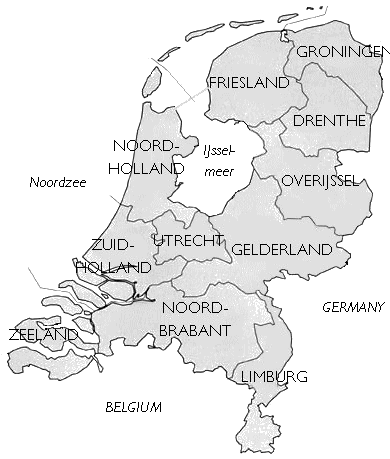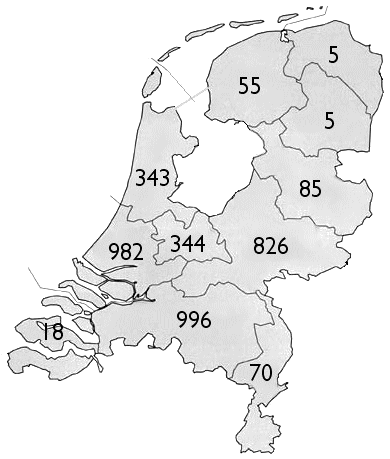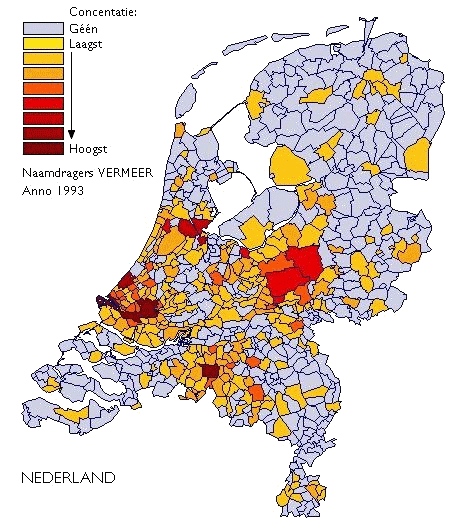
Map of the Netherlands and it's 11
historical provinces.
In the second half of the 20th century land was
won in the southern part of the IJsselmeer which became the
12th province. It is called Flevoland.
Before the enclosure dike was build (finished in 1932), the
IJsselmeer was an open sea and it was called the
Zuiderzee.
Introduction.
In the last ten years our database has grown to
over 90,000 personrecords. We learned more about
how our family has spread and where our ancestors
originally came from. Ninety thousand sounds a
lot, but it is likely that tens of thousands of
forgotten names and people still ly waiting in the
archives to be discovered. They will possibly make
new connections between up to now not connected
families.
In this article I will try to explain the meaning
of our surname and I will try to name some places
where our ancestors derived their name from.
Long time ago when Europe's population was
small, people where known by just one name: what
we now call "first name". Population grew it
became necessary for people with the same name to
distinguis themselves from one another. People
added a second name which referred to their
occupation, place of origin, a nickname or
refering to another person (a close relative).
For example: John Carpenter, David London,
Edward Tall and Henry Jacobson (=son of Jacob).
Once such a name went over from father to son it
became a surname as we know today. Of course this
happened sooner in high density populations like
in cities and much later in rural areas.
In the Netherlands it became common to have names
that consisted of two or three parts: a first
name, a patronymic and a surname. For example:
Jacob Evertsen (son of Evert)
Vermeer or Cornelia Peters (daughter
of Peter) Vermeer. In rural areas people
only occasionally use their surname which makes
research much more difficult.
What does our name mean (1)?
In Dutch 'meer' means lake, so it will not
surprise you that our ancestors once live near
water or a town that was called after a lake.
These people settled elsewhere and called
themselves after their place of origin. The prefix
'Van' or 'Van der' or 'Ver-' all mean from
or of.
A lake can be described as sweet and stagnant
waters surrounded by land. In the Dutch language
there are more names for stagnant water like
vijver, laak, ven, poel, plas and put,
although these terms are not always replaceble.
Meer is dirived from mari in German and
goes back to the Latin word mare. In the
Dutch language in the Middle Ages it meant both
lake and sea. Not all meanings of the word meer
in the Middle Ages can be used today. It was also
the word for all kinds of puddles, pools and
swamps.
From these meers several familynames were
dirived: Meer(e), Van der Meer(en), Meir(en), Van Meer, Ter Meer, VERMEER, Vermehr, Vermeir,
Vermer(en), Vermeer(s)(ch), Meer-, Merre-, Meir(e)man(s)
and even more variations. Interesting to know is
that Vermeers(ch) means 'son of Vermeer'.
An important question is if we can discover the
exact place where our ancestors once lived and
took their name from. A complete and balanced
answer that applies for all families can not be
given. Not every person with the Vermeer name in
the same region will share the same ancestors but
we do have strong leads for some of the largest
familes. Our records show there are at least three
or four places that likely have been the places of
origin.
Where did our ancestors come from?
.gif) Places
of origin and the first spreadings of the family
name.
Places
of origin and the first spreadings of the family
name.
Gelderland.
In Gelderland the name of Vermeer has been
found in the 13th and 14th century in the eastern
parts between Arnhem and Nijmegen
(2). Parts of this region have been both
Dutch and German ground alternately. Today
just over the border in Germany, south of
Millingen is the town of
Mehr, which is the first plausible place of origin.
The second possible place of origin is a tiny
stream simply called 'Het Meer' close to the town
of Beek within the municipality of Ubbergen.
This is the most likely because the oldest records
show that a lot of Vermeer's owned land in this
area. These Vermeer's are the oldest ancestors of
the Vermeer of the Betuwe who occupied executive
functions like bailiffs, judges, dike-reeves,
church masters and so on. Because in these days it
was common that these functions passed on from
father to son it is possible other families in
Gelderland who occupied simular functions also
descent from this same family.
Noord-Brabant.
The oldest records of Vermeers in this province
come from the city and the area south of Tilburg.
In Noord-Brabant we have found the most manners of
writing, even within the same family!
Unfortunately we hardly have seen records in
Vlaanderen (Flanders, Belgium) just below the
Dutch border where also Vermeers have lived and
still live. It is very well possible most
Vermeer's in Noord-Brabant thank their family name
from the Flanders town of Meer also written as
Meir just at the other side of the border.
In Brabant there are families from Raamsdonk,
Udenhout, Loon op Zand, Haaren, Waalwijk,
Woensdrecht and five families of Tilburg.
Noord- & Zuid-Holland.
In the western provinces there is not one
particular place that stood at the beginning of
our familyname. The coastal area has always been a
region with lots of greater and smaller rivers,
lakes and swamps. According to the Meertens
Institute the 'Van der Meer' name in Zuid-Holland
originates from the Zoetermeer Lake. It is
striking to see that the olderst generations of
Vermeers in Bleiswijk, Zevenhuizen, Pijnacker and
surroundings, also came from around Zoetermeer and
it's lake. It seems that also the Vermeer name was
named after this lake. The source of Vermeers in
Rotterdam seems to be located more to the north
too, and maybe from the same area.
A second place of origin is the town of
Meerkerk where a large family has grown with
branches in Hillegom, Leiden, Haarlem and
Uitgeest.
Other provinces.
Maybe you have already missed some areas in
the Netherlands. There are Vermeer families living
in Friesland: the Vermeers of Haskerland and the
Vermeers of Bolsward. Both families came from
elsewhere, respectively from Haarlem at the
beginning of the 19th century; and likely from the
Betuwe (3) area in the 18th century.
The city and province of Utrecht has always been
the home of Vermeers. Numbered together it is a
reasonable group but unrelated to each other and
likely originated from elsewhere. In the town of
Maarssen near the Vecht river a family named Ter
Meer was founded.
Other provinces like Zeeland, Limburg, Drenthe and
Groningen did not play a significant role or no
role at all in the history of our familyname.
About the Losecaat Vermeer surname.
In 1811 Isaak Weijer Vermeer married Geertruida
Helena Losecaat. In 1846 he and his children were
given permission to add Losecaat to their
familyname. The Losecaat Vermeer family is a
branch of the Vermeer family of the Betuwe.
About the Rhemrev surname.
Rhemrev is Vermehr written backwards. A
few centuries ago in the region between Arnhem and
Nijmegen in the province of Gelderland and close
to the German border Vermeer was also written as
Vermehr. One member of this family went to the
Dutch East-Indies (now Indonesia) with the
Verenigde Oost-Indische Compagnie (VOC = [Dutch]
United East-Indian [Trading] Company.
In the Dutch East-Indies there was a lack of
European women. Men often had a 'njai', a native
housekeeper, who often was more then a servant
only. It was a completely accepted phenomenon for
a long time and even recommended for civil
servants to be, because it was better than flee
into alcohol or visiting prostitutes.
Children born from these relationships grew up
with their father also if he later got married to
an European woman. The child was given the name
surname of his natural European father but written
backwards. This became officially when they were
recognized by their fathers by civil registrars
which became possible in 1828. This is how Vermehr
became Rhemrev.
Leendert Hendrik Vermehr (aprox.1737-1790) had a
son with his Javanese njai. This son, Leendert,
was born in about 1758 and later got married and
he had six children: four sons and two daughters.
He and his four sons together are the ancestors of all
Rhemrev's that live around the world.
The earlier mentioned Leendert Hendrik Vermeer was
a son of Lubertus Vermehr (1696-1749) and Cornelia
van Westhoven. You can find them in the survey of
the Vermeer family of the Betuwe which starts in
the early 15th century.
Spreading.

The map displays the number of Vermeers in each
province according to the 1947 census. It is clear
that the regions where most families originate
from still have the highest concentrations of
Vermeers. What can not be seen is that Vermeers
from Brabant have spread out to Zuid-Holland,
especially to Rotterdam and Vlaardingen. In
Noord-Holland -at De Rijp and surroundings- there
is a large stake of Vermeers that originates from
Wageningen.
In the 19th century, between 1840 and 1910,
many Vermeers emigrated to the USA and Canada.
After the WWII a second wave of emigrants moved
to North-America, Australia, New Zealand and
South-Africa.
See also our page about
imigrants.
Numbers.
At the time of the 1947 census there were 4,626
Vermeers, 8 Losecaat Vermeers and 30 Rhemrevs
living in the Netherlands. The number of namesakes
at this moment must be almost 8,000
(4). This is an
estimate calculated on the basis of the 1947
census and growth of the Dutch population between
1947 and 2006, which was 69%.
The variation of 'Vermehr' does no longer exist in
the Netherlands and only a handful lives in central Germany. We do not know if they originated from
the Netherlands.
A large number of Rhemrev came to the Netherlands
in 1949 after Indonesia (the former Dutch East
Indies) claimed independence. Some went to
Australia and the USA, only a few remained in
Indonesia.
by Rendert Vermeer, database
manager
this article is also published in Alweer een
Vermeer, no.20

References and accounts.
AeV = Alweer een Vermeer, our magazine
1) Meaning. Most of this text was written by the Meertens Instituut,
www.meertens.knaw.nl ;
see explanation of the names Vermeer and Van der Meer.
2) Old records from Maas and Waal: in AeV 14, p.16.
3) Earliest ancestor of the Vermeers of Bolsward: in AeV 15,
p.8.
4) Centraal Bureau voor de Statistiek, www.cbs.nl
Population 1947: 9.669.000; Population 2005: 16.306.000
Calculation growth 1947-2005:
16.306.000 / 9.669.000 = 1,69
(1,69 - 1) x 100 = 69 %
Number of Vermeer's in 1947: 4.626
Expected number of Vermeer's in 2005 on base of
growth of total population in the Netherlands: 4.626 + 69% =
7.818
The map at the right gives an
impression of the concentrations of Vermeers
living in the Netherlands according to the 1993
telephone directories.
Blue = none, yellow = lowest, dark brown = highest
concentrations.




.gif) Places
of origin and the first spreadings of the family
name.
Places
of origin and the first spreadings of the family
name.

